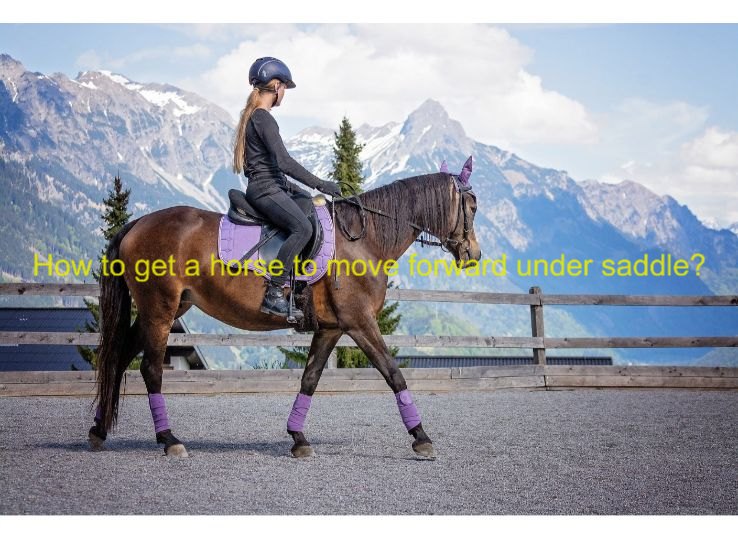How to Get a Horse to Move Forward Under Saddle?

Without forward movement, you can’t train your horse. Imagine having the keys to a brand-new BMW without the gas pedal like you were given a horse that doesn’t move. So, it is best to learn how to get a horse to move forward under saddle.
Table of Contents
How to Get a Horse to Move Forward Under Saddle? 5 Easy Steps
A clear understanding of how to communicate with horses is necessary to get them moving forward. A horse will move willingly if its direction is clear and it does not receive mixed signals. Here is an easy guide on how to get a horse to move forward under the saddle for beginners.
-
Get the horse’s attention
-
Make sure you cluck, squeeze, and spank appropriately.
Squeeze, Cluck, and Spank are three separate commands you can use to teach horses how to walk at the speed and gait you want. Squeeze the horse’s rib cage gently to initiate forward movement with your legs. Squeezing the horse gently gets it moving forward.
You should squeeze with your legs and cluck twice with your tongue, “Cluck, cluck,” if he doesn’t move forward immediately. Clucking lets him know that he’s about to feel uncomfortable if he doesn’t move. Use a dressage whip to tap him behind your leg until he walks forward if he still does not respond.
If you still can’t get him to change his mind, continue to squeeze with your legs and spank him until he walks forward. When the horse ignores your cues, spanking makes him feel uncomfortable.
Please don’t squeeze the sides, cluck, or spank the horse as soon as he walks forward. If the horse is moving at the speed you want, the legs should hang loosely against its sides. Don’t exert any pressure on the horse.
-
Give a Verbal Cue
Sound can be used to cue a horse when it’s time to move, in addition to physical cues. If you want to get the horse going, make a couple of short clicking or kissing noises.
-
Give Clear Commands
Make sure you do not create any obstacles for the horse to overcome. As you ask the horse to move forward, do you pull the reins back or lean back? Look at your body language to ensure you are not sending the horse confusing signals
-
Kicking does not Promote Forward Movement
Kicking to go won’t work. Jockeys would do kicks if they were an effective forward cue. Keep your gait relaxed-you don’t want to be responsible for forwarding movement. It’s better to build up pressure with the crop before releasing it when the horse is willing, rather than using one big tap.
Rather than going in circles, take long, straight paths. The horse should only be allowed to run for a short time, then be left alone.
Read More: How to Steer a Horse with Reins like a Pro? [Latest Guide]
To Deal with a Lethargic Horse
- Avoid kicking to go. If thrusting was a good forward signal riders would do it.
- Avoid working to go or continue the gait—you don’t need to take charge for forward cue.
- Avoid using a crop having one large tap; in its place, use it to create pressure and release once the horse obeys.
- Go in long, straightforward lines instead of circles.
- Request only for a small burst of speed; after that, allow the horse alone for 60 seconds.
Get determination! Do something that unties your horse’s mind and lets him to seem where he is working and occupy in an action. Go out on a way, follow a buffalo or add some entertaining trials in your arena.
Frequently Asked Questions
Q: Why would a horse refuse to go forward?
The four most common reasons for a horse to resist or deny its rider are pain, miscommunication, fear, or disrespect. The underlying cause of the problem needs to be identified and addressed.
Q: When you want a horse to go, what do you say?
Most people click their tongues or cheeks to get the horse moving. The act is called “clucking” or “clicking”.
Q: How do you motivate a lazy horse to move forward?
Start from a halt. Simply tighten your calf a little and ask your horse to trot on. Then give a much harder kick with your leg immediately if no response is received. The horse should be able to canter energetically, not just jump forward.
Conclusion
This was our easy and simple guide on how to get a horse to move forward under the saddle. The process doesn’t have to be complicated. You only need to follow our instructions to make your horse move forward.



![How to Cut Horse Stall Mats: [ Latest Guide in 2024] 5 How to Cut Horse Stall Mats: [ Latest Guide in 2024]](https://animalpedias.net/wp-content/uploads/2022/01/how-to-cut-horse-stall-mats.jpg)


![Top 10 best horse breeds of all time: [Latest Guide in 2024] 8 Top 10 best horse breeds of all time: [Latest Guide in 2024]](https://animalpedias.net/wp-content/uploads/2021/10/best-horse-breeds--768x384.jpg)